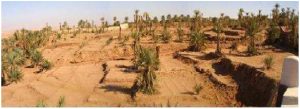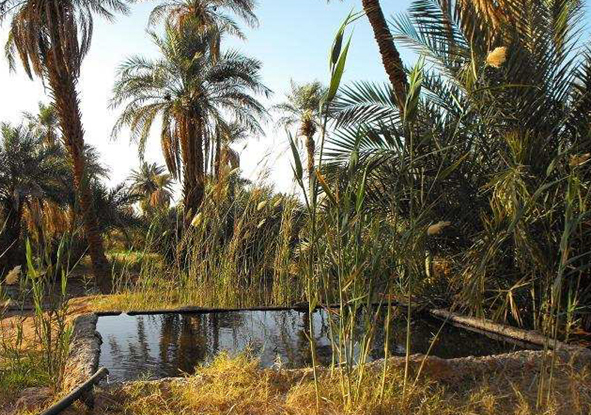Waterworks
The function of a Foggara
With the force of gravity the foggaras gently transport the water from the water table to the exit point (also called spring or mouth). The exit point of the foggara is at a level slightly higher than the plots, creating gravity irrigation. At the entrance of the grove one or more “comb” distributors (kesrias) leads the water to a network of primary and secondary channels and then to the plots. When the foggara reaches the palm grove, it is diverted into multiple channels, thus creating a tree structure that feeds many retention ponds (madjen), which in turn feed the arable plots.
The problem in the foggara of Timimoun and possibilities for action
Unfortunately, in April of 2000 the main foggara of Timimoun, the foggara “Ifli Amokrane”, which dated from before the 5th century AD, was damaged, due to the collapse of its 500 meter gallery. This resulted in the loss of a hundred hectares of palm grove.

Hydria Virtual Museum
Currently (2011), the Directorate of Hydraulics of the Wilaya d’Adrar (administrative equivalent to the government departments in France) is in charge of the maintenance works in the gallery itself up to the exit point and the distributing “comb”. However, the task of restoration after the “comp” i.e. the seguias (channels); the kesrias (distributing combs); the madjens (water ponds) from the exit point of the foggara however, remains entirely to the farmers.
Another solution that was considered involves the installation of small pumping stations in the palm grove, to be powered by photovoltaic energy (as the fellahs don’t have the necessary funds to cover the electricity cost for the pumps situated upstream, which could be connected to the supply network). Connection to the network is feasible since the water table is at a depth that does not exceed ten metres. Such a solution however, would be very costly and would entail the following issues:
- The water from the wells in the palm grove would quickly become brackish and therefore inappropriate for irrigation especially as we move downstream to the sebkha
- The maintenance of the pumps would requires technical skills and would therefore entail training the users
- The life expectancy of the photovoltaic panels would be short due to climate. Unless they are sufficiently protected from the air and sand, which are both very violent at times, their surface would quickly become abrasive thus causing a decrease in performance.
- The installation of pumping units would pose an organizational issue, because currently the ancient system of foggaras connects the community under a commonly shared water management system, supervised by a single supervisor.
- Finally, this solution would create tensions, thus rendering the surveillance of the pumps necessary on a permanent basis.
Inventory and flow rates
Currently the use of the foggaras in these regions of Algeria requires a new solution to the issue of its maintenance since its traditional cleaning method is laborious and tedious requiring a specialized know-how. Lack of this traditional knowledge of maintenance has reduced the number of functional foggaras from over 1400 to only 900 combined with a steady decrease in the flow and the depletion of the aquifer. This reduction is further aggregated by the drilling of new wells and boreholes.
The water capacity in the foggaras’ region (determined by several models e.g. ERESSI, OSS.BRL) is about 1.4 billion m3 per year with annual water withdrawals in the range of 510 hm3 from the ~590 operating wells and another 90 Hm3/yr from the ~900 operating foggaras. (1 hm3 = cubic hectometer = 100m X 100m X 100 m = 1 million m3)
Another problem relates to the inability to use the foggara’s water upstream, where the soils are usually of good quality, contrary to the soils located downstream, which are usually salted and water saturated.
The allotments
Since the liberalization of land ownership, the old fellahs, returning immigrants and others, having little or no access to the foggaras, used wells and pumps to get water. They also settled beyond the palm grove, creating small farms of 1-2 ha, situated around the wall of the toub, demonstrating the collapse of the old system. Obviously in this society, which was shaken by the sudden intrusion of the modern world, not everyone is equally concerned with the preservation of the foggaras.
The introduction a few years later of pivot irrigation with sprinklers fed by wells allowed the plots to extend from just a few hectares to tens or hundreds of hectares. The use of wells that reach the water table (20 to 80m depth) or the deep aquifers (more than 100m depth) allows the production of 30 to 50 litters of water per second, the equivalent of what is produced by 15 to 25 km of foggaras. Boreholes electrified by the conventional power network also allow the appropriation of space previously not available.
Moreover, the region witnesses the development of investment groups whose objective is apart from removing the social constraints of foggaras is to create agricultural cooperatives of several hundred or thousand hectares. Boreholes and irrigation channels are intended primarily for the cultivation of feed grain, or other agro-industrial products, to the detriment of palms.
In total, the impact of all the abovementioned actions is that in Timimoun region 40m3of water per second are collected from deep aquifers, raising the removal rate from 0.05 ls/hab in 1960, to 11 ls/hab in 2005.
The impacts
No hydrogeologist can deny that there will be a lowering in the water table level that will progressively affect the foggaras, on which the old palm groves still depend. In other words, the price of success in “pioneering” new farmers will be the collapse of the traditional system in the medium term. This phenomenon is already taking place.
The use of renewable energies, solar and wind and the reconciling between the current requirements and the traditional agriculture should be openly debated by all stakeholders (multidisciplinary scheme) in order to identify effective measures.
Solar and wind energy is of primal importance for many countries, including Algeria, who have a strong potential for this type of renewable energies. Supporting Research & Development in this field can indeed grow the share of solar and wind energy. However, the technological progress and the commercial applications of renewable energies strongly depend on political commitment.







